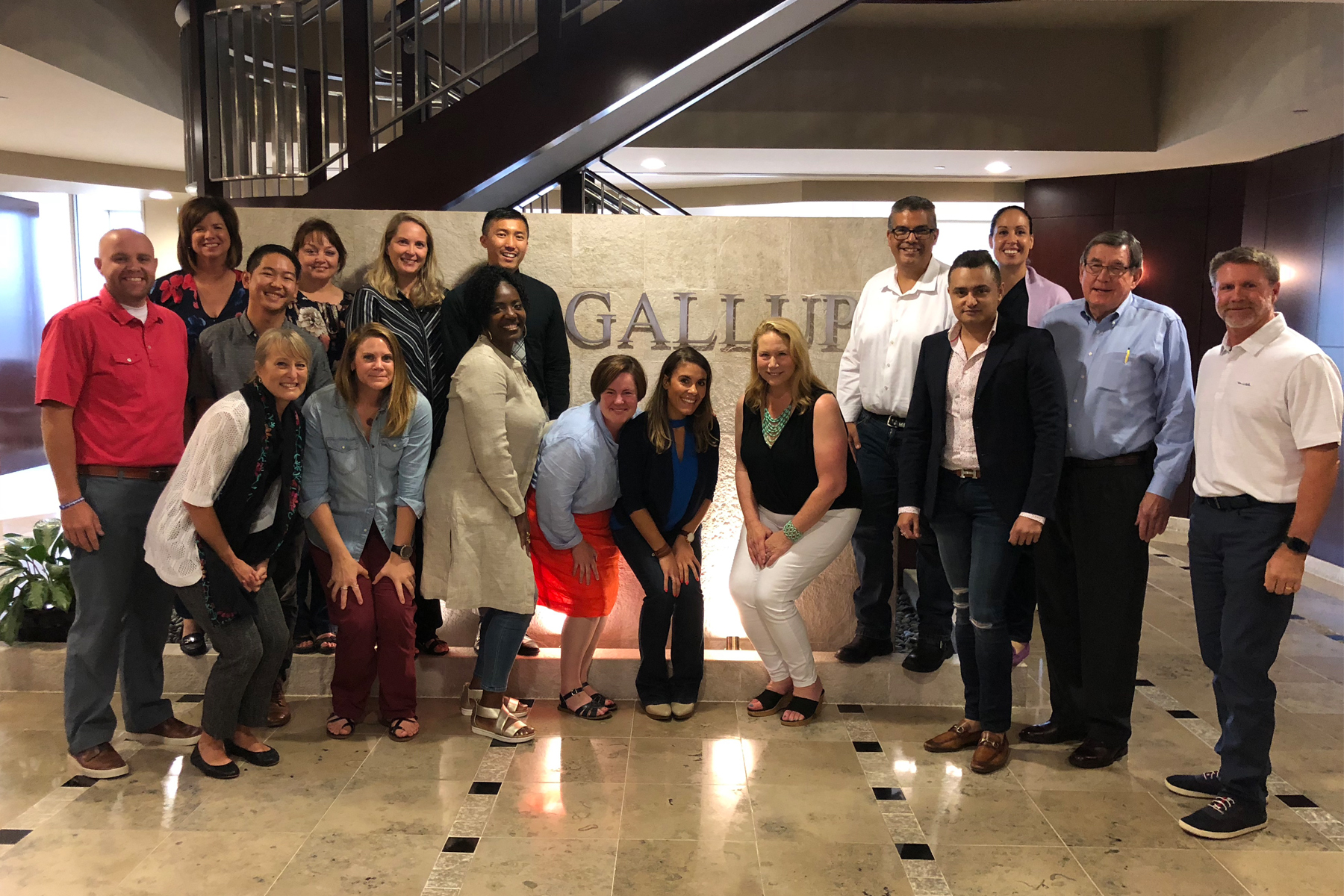Literature Review

Becoming an Inspiring Developer Through Coaching
Understanding the art of coaching, implementing the articulation of coaching approaches, and building an arsenal of coaching tools is essential to becoming an inspiring developer.
Amidst many challenges in the workplace, there is a call for leaders to be an inspiring developer committed to coming alongside others as an effective coach who empowers others to their full potential. According to Gallup’s, “State of the American Workplace” (2017) report “three in ten U.S. employees strongly agree that there is someone at work who encourages their development” and that lack of development is the No. 1 reason employees leave their job (p. 110). Therefore, development is typically an unwritten set of expectations that workers anticipate, and coaching is one way that managers could be an inspiring developer who increases value, development, and productivity. Effectively developing people and ideas in ways that are authentic and appropriate is the mark of an inspiring developer (Leadership, n.d.). Understanding the art of coaching, implementing the articulation of coaching approaches, and building an arsenal of coaching tools is essential to becoming an inspiring developer.
The Art of Coaching
Coaches regularly help others channel their passion to learn into great opportunities through a process of equipping them with developmental tools, knowledge, and opportunities (Peterson & Hicks, 1996). The International Coach Federation (ICF) defines coaching as “partnering with clients in a thought-provoking and creative process that inspires them to maximize their personal and professional potential” (Wax & Wertheim, 2015, p. 41). As a result, clients are the experts while their coaches have the responsibility to discover what their clients want to achieve, encourages self-discovery, and elicits client-generated solutions and strategies (Wax & Wertheim, 2015). These coaching relationships consist of the following self-development strategies: focus on priorities, implement something every day, reflect on what happens, seek feedback and support, and transfer to the next step (Peterson & Hicks, 1996). Through the coaching framework: forge a partnership, inspire commitment, grow skills, promote persistence, and shape the environment, effective coaching begins to not only impact individuals, but also entire organizations. Overall, that development takes place amongst three coaching frontiers: “working one-on-one (direct and personal), guiding people to learn for themselves (becoming lifelong learners), and orchestrate resources and learning opportunities (foster environments for continuous learning)” (Peterson & Hicks, 1996, p. 15). Through coaching, inspiring developers are able to demonstrate a commitment to mentorship, design meaningful learning experiences and environments through empowering conversations, and utilize theories and practices of adult education (Leadership, n.d.). Understanding coaches’ responsibilities and relationships inform coaching with compassion while coaches’ frameworks and frontiers develop an effective learning environment for adult learners.
Coaching with Compassion. Compassion consists of empathy, care, and acting in response to other’s feelings (Boyatzis et al., 2006), which informs five types of coaching conversations: the role and relationship orientation, quick connects, check-ins, developmental coaching, and progress reviews (“State of the American workplace,” 2017). As an interpersonal process of recognizing needs, coaching with compassion encourages positive emotions, increase in openness, and renewed Ideal Self rather than their Ought Self (Boyatzis et al., 2006). There are two primary components of coaching with compassion: helping the client develop their own compelling personal vision and identifying strengths before weaknesses. Coaches have the opportunity to lean into relationships through the informed practice of coaching responsibilities.
Environment for Adult Learners. However, in order for effective coaching to take place, coaches must “create and foster a situated learning environment by creating effective and trusting relationships, fostering coachee experimentation, and engaging in reflective learning from experience” (Campone, 2011, p. 60). Transformative adult learning changes how people see themselves and the world through four models: clinical, behavioral, systems, and social constructionist (Campone, 2011). For adult learners, balancing the demands of life, time management, and organization adds to the anxiety of being back in school, but coaches can often help individuals maintain both focus and motivation (Wax & Wertheim, 2015). Coaching is a partnership where adult learners are encouraged to recognize their advantages and challenges in order to “capitalize on the advantages while diminishing the effects of the challenges” (Wax & Wertheim, 2015, p. 44). Cultivating and curating effective learning environments empower coaching sessions that invite learners into healthy engagement with who they can become.

The Articulation of Coaching Approaches
There are such diverse needs, challenges, and approaches throughout coaching and oftentimes, coaching is defined by an articulation of various coaching approaches accompanied by various dynamics of a coach’s style. When it comes to understanding that articulation, there is a copious amount of research on a variety of different coaching theories and approaches. By leveraging the strengths of these theories and approaches, inspiring developers are able to develop people and leaders at every level through performance feedback, executive coaching, and career development while reconceptualizing mistakes amidst conflicts as learning opportunities (Leadership, n.d.). Through positive psychology, narrative conflict coaching, and action frame theory, the art of coaching is implemented with methodical purpose, credibility, and significance as a part of a growing profession known to inspire and develop people.
Positive Psychology Coaching. As a science, positive psychology is at the heart of coaching where positive psychology coaching (PCC) seeks to improve short-term and sustainable wellbeing using evidence-based approaches of positive psychology to enable ongoing application (Passmore & Oades, 2014). There are four key positive psychology theories: strengths theory (ST), broaden and build theory (BBT), self-determination theory (SDT), and wellbeing theory (WT). Strengths theory (ST) is where “people will perform, feel and function better if they are using their strengths” (Passmore & Oades, 2014, p. 69). Broaden and build theory (BBT) proposes experiences of positive emotions broaden momentary thought-action repertoires in various situations. Self-determination theory (SDT) is a set of theories that examine the effects of motivation through three psychological needs: (a) autonomy; (b) relatedness, and (c) competency. When these needs are met, autonomous motivation and greater perseverance in accomplishing tasks grow in decision making capacities. Finally, wellbeing theory (WT) or PERMA theory suggests five domains of developing wellbeing: positive emotions, engagement, (positive) relationships, meaning, and accomplishment. These four theories are a part of the makeup of positive psychology coaching that encourages coaches to build up the wholeness and wellness of the people they coach.
Narrative Conflict Coaching. Through conflict analysis and a narrative perspective as a collaborative product of conversation, narrative conflict coaching becomes an effective approach toward conflict resolution. Established in 1994, Stern commented on the potential of addressing conflict management within executive coaching, which led to conflict coaching as “the process in which a coach and disputant communicate one-on-one for the purpose of developing the disputant’s conflict related understanding, interaction strategies, and interaction skills” (Brinkert, 2006, p. 518). Integrating the point of view and context such as interpersonal, organizational, and cultural factors, conflict coaching involves a wide variety of relational circumstances. With a narrative perspective, conflict coaching extends beyond instruction and performance strategies, but rather through collaborative conversations strategies emerge instead of the consultation of a professional (Winslade & Pangborn, 2015). According to Brinkert (2006), there is a five stage to conflict coaching model: listening for the story and setting (stage one), inviting multiple perspectives (stage two), clarifying the intentional story (stage three), offering opportunities for living the story (stage four), and facilitating story review and (re)direction (stage five). Those stages are also informed by three territories of conversation and the three criteria of an event that informs narrative conflict coaching. To ensure that the conflict story is fully understood, the three territories provide greater clarity and consists of understanding the conflict story, asking questions to deconstruct the conflict story, and again asking questions to grow a counter story (Winslade & Pangborn, 2015). Finally, the three criteria of an event: denotation (facts about what happened), manifestation (beliefs and desires of the persons involved), and signification (relationship between what happened and its implications), aids the explanation of an event (as cited in Winslade & Pangborn, 2015). Amidst conflict that derails organizations and individuals, narrative conflict coaching is an approach that develops healthy reconciliation between diverse challenges and perspectives.
Action Frame Theory. Within a result driven culture due to the organizational emphasis on having a return on investment, action frame theory (AFT) provides a diagnostic approach to reframe and enrich the origin and development of undesired behavior (Cocivera & Cronshaw, 2004). Action frame theory is a synthesis of social action and functional job analysis, which assists executive coaches to understand executive actions, behaviors, and consequences. Executive coaching can be best understood through Kilburg’s Model of Executive Coaching, which consists of four stages: defining the context, assessment of the executive, feedback and development planning, and implementation and follow-up (as cited in Cocivera & Cronshaw, 2004). With Kilburg’s executive coaching model, there is a seamless integration with action frame theory and the seventeen dimensions of executive coaching that are classified into three foci: system focus, mediated focus, and executive focus (as cited in Cocivera & Cronshaw, 2004). As a result, action frame theory “provides the analytical framework to help executive coaches determine the desired consequences and how they can be and are being achieved” (Cocivera & Cronshaw, 2004, p. 243). Through the five basic components in action frame theory: conditions, means, action, results, and consequences (Cocivera & Cronshaw, 2004), there is a clear process for developing executives who carry significant responsibility for their organizations. Being able to leverage research and articulate coaching theories and approaches, inspiring developers strengthen their art of coaching as well as their foundation in the profession.

The Arsenal of Coaching Tools
When it comes to becoming an inspiring developer, there is a compelling need for coaching throughout organizations as employee retention has become a significant concern and cost for many organizations (Hebenstreit, 2007). Supervisory integrity, trust in leadership, collaborative work environment, sufficient time off, innovative work, supervisory support, and fair and just use of power are seven factors that are influenced, controlled, and affected by individual managers and supervisors, which affect the work environment and organizational climate (Hebenstreit, 2007). According to Hebenstreit (2007), organizations have started to implement solutions to address the challenge of employee turnover, focusing on:
Career development opportunities
Challenging and meaningful work in alignment with employees’ career interests
Employer’s culture and reputation
The organization’s commitment to the employee and employee level of job involvement
Organizational and supervisory support (including relationship with supervisor)
Honest and truthful recruitment processes
Compensation- and rewards-related retention mechanisms (p. 4).
Considering that employee motivation is linked to work environments and relationships, building an arsenal of coaching tools could not only provide insight and explanation to the challenge of retention and motivation, but leads to an increase in inspiring development in organizations. Further research can be developed in the opportunities for organizations to know their employees’ preferences, personas, and strengths and how they integrate as well as interact in the workplace for inspiring development.
Knowing Preferences, Knowing Personas, and Knowing Strengths. Considering that organizations are the collection of individuals in a workplace, being able to know their preferences, personas, and strengths. Overtime, personality assessments have been utilized to develop greater self-awareness and often with the help of a coach that awareness becomes action. Knowing preferences starts with the self-reported questionnaire, the Myers-Briggs Type Indicator (MBTI), designed to make Jung’s theory of personality type understandable useful in everyday life (Myers, 2015). Overall, the eight different preference pairs articulate differences in directing and receiving energy (Extraversion and Introversion), taking in information (Sensing and Intuition), decision making (Thinking and Feeling), and orientation to the outside world (Judging and Perceiving) (Myers, 2015). Understanding preferences allow individuals to have a better understanding of how they interact with the world around them. While knowing personas starts with the Enneagram, which according to Cron (2016), “teaches that there are nine different personality styles in the world…Each type or number has a distinct way of seeing the world and an underlying motivation that powerfully influences how that type thinks, feels and behaves” (p. 24). The nine types are “perfectionist, helper, performer, romantic, investigator, loyalist, enthusiast, challenges, and peacemaker” (Cron, 2016, pp. 25-26) and each style can reveal an individual’s views, choices, values, motivations, reactions, and response to stress (as cited in Matise, 2007, p. 55). When these nine styles are developed they move from self-forgetting to self-remembering where attention and energy shifts toward the development of positive traits (Matise, 2007). Finally, Strengthsfinder is a tool for gaining awareness on talent to capitalize and apply them to challenges and each member has their own unique strengths that exist in four distinct domains of leadership: “executing (making things happen), influencing (reaching a broader audience), relationship building (essential glue that holds the team together), and strategic thinking (focus on what could be)” (Rath & Conchie, 2008, p. 22-23). As a result, strengths-based coaching consists of four overarching themes: intrinsically motivating and energizing, strengths develop through relationships, expert strengths work does not ignore a leader’s blind spots or shadow sides, and development hinges on a coach’s attitudes about their own development (Welch, Grossaint, Reid, & Walker, 2014). When individuals and teams gain self-awareness, they are able to effectively develop name, aim, and claim their real best selves.
Integration of Coaching Tools. Overall, the art of coaching and articulation of coaching approaches are established, but its expression is diverse and limited to particular styles. Building an arsenal of coaching tools has the potential to empower coaches for holistic development, but research is limited when it comes to developing an integrated tool belt for effective coaching. Currently, knowing preferences through the Myers-Briggs Type Indicator (MBTI), knowing personas through the Enneagram, and knowing strengths through Strengthsfinder, coaches are able to develop individuals by leveraging positive psychology, narrative conflict coaching, and action frame theory through these assessment tools. Becoming an inspiring developer through coaching leaders become champion learners, change agents, and catalytic activators.
References
Boyatzis, R. E., Smith, M.L., & Beveridge, A. (2012). Coaching with compassion: Inspiring health, well-being, and development in organizations. The Journal of Applied Psychology, 49(2), 153- 178.
Brinkert, R. (2006). Conflict coaching: Advancing the conflict resolution field by developing an individual disputant process. Conflict Resolution Quarterly, 23(4), 517-528.
Campone, F. (2015). Executive coaching practices in the adult workplace. New Directions for Adult & Continuing Education, 2015(148), 59-67.
Cocivera, T., & Cronshaw, S. (2004). Action frame theory as a practical framework for the executive coaching process. Consulting Psychology Journal: Practice and Research, 56(4), 234-245.
Cron, I. M. (2016). The road back to you: An enneagram journey to self-discovery. InterVarsity Press. Kindle Edition.
Hebenstreit, R. K. (2008). A call to apply the principles of the enneagram in organizations to attract, retain, and motivate employees. The Enneagram Journal.
Leadership, M.A.: Competencies. (n.d.). Retrieved from http://www.apu.edu/bas/programs/masters-in-leadership/about/competencies/
Matise, M. (2007). The enneagram: An innovative approach. Journal of Professional Counseling: Practice, Theory & Research, 35(1), 38-58.
Myers, I. B. (2015). Introduction to Myers-Briggs Type. CPP, Inc.
Passmore, J., & Oades, L. G. (2014). Positive psychology coaching – a model for coaching practice. Coaching Psychologist, 10(2), 68-70.
Peterson, D. B., & Hicks, M. D. (1996). The leader as coach: Strategies for coaching and developing others. Minneapolis, MN: Personnel Decisions.
Rath, T & Conchie, B. (2008). Strengths based leadership: Great leaders, teams, and why people follow. New York, NY: Gallup Press.
State of the American workplace. (2017). Gallup Inc. Retrieved from https://www.gallup.com/workplace/238085/state-american-workplace-report-2017.aspx
Wax, D. M., & Wertheim, J. (2015). Coaching as a Strategy for Helping Adults. New Directions for Adult & Continuing Education, 2015(148), 39-48.
Welch, D., Grossaint, K., Reid, K., & Walker, C. (2014). Strengths-based leadership development: Insights from expert coaches. Consulting Psychology Journal: Practice and Research, 66(1), 20-37.
Winslade, J., & Pangborn, A. (2015). Narrative conflict coaching. Narrative and Conflict: Explorations in Theory and Practice, 2(1), 90-118.